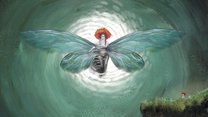Song of Nunu: A League of Legends Story review

- 0 Comments
Charming spinoff hits many of the right notes in 3D platforming adventure
On a list of non-adventure game franchises likely to make the leap to single player, narrative- and puzzle-driven experiences, League of Legends probably wouldn’t rank near the top. Riot Games’ free-to-play popular isometric multiplayer online battle arena has been all about team combat since its inception in 2009. Lately, however, it’s started branching out, not only to other mediums such as comics, music, and an animated television series, but to entirely different game styles, from a digital collectible card game, to a tactical shooter, to as-yet-unreleased roleplaying titles. Surprisingly, it’s now also dabbed its toe in action-adventure waters in the form of Song of Nunu: A League of Legends Story. Far less surprising is that in the experienced hands of Tequila Works (RiME, The Sexy Brutale), Song of Nunu is a charming, highly accessible 3D platforming journey for all, no prior familiarity required. It’s certainly not the deepest game, being child-friendly if not outright child-centric, but it’s a pleasantly chill experience throughout, in more ways than one.
Although getting the sole headline credit, the gap-toothed Nunu is only one half of the game’s heroic duo. He’s just a child in a cute floppy-eared, button-eyed hat, a Notai boy who was separated from his mother when their caravan was attacked. Convinced she’s still alive and determined to find her, Nunu undertakes numerous adventures throughout the perpetually wintry Freljord with his pal Willump, a loveably gruff blue yeti, the last of his kind. When Nunu begins experiencing dreamlike visions of his mother urging him to find “the Heart of the Blue” in the mountains on the horizon, their course is set. Of course, it’s not going to be easy to get there, as there are numerous obstacles and dangers in their path.
You’ll often control Nunu on foot, but for a good chunk of the game you’ll get to climb up on Willump’s shoulders. Together you’ll lumber through snowbound plains, forests, mountains, lakes and caves, descend into the depths of a volcano, and even sneak into a menacing castle belonging to your foe, an Ice Witch named Lissandra, who is determined to acquire the same mysterious artifact – whatever it may be; Nunu’s dream mother speaks only cryptically of it, much to his impatient dismay. Being much larger, stronger and faster (at least when running on all fours), Willump can power through or climb up and over barriers that Nunu alone could not, but you’re never given a choice of when to ride or dismount your yeti buddy. Instead he’ll automatically swoop you off your feet until Nunu requests to be let down all on his own when circumstances require it. You can, however, ask for a boost at certain spots to continue on alone.

Being just a “tiny” lad, Nunu has far less physical prowess, but he can still jump, grab and shimmy across clearly indicated ledges. Navigation can be done through keyboard/mouse, but a controller is recommended and indeed feels much more intuitive. It’s also very forgiving, apart from a few finicky areas – so much so, it almost feels like you’re being magnetically pulled to your next grippable surface. Unless you slip, that is, at which point a little button mashing is required to regain your footing. Miss a landing or fall too far and you can die, but the consequences are nothing more than a quick fade to black before respawning at the nearest generous checkpoint to try again.
Nunu and Willump love the snow, and snowball fights in particular; the yeti more than the boy because he’s infinitely better at them. (The two will square off at pre-scripted moments, and if it’s possible to beat the FOUR-armed Willump, I sure wasn’t able, which was annoying.) Fortunately, in between getting pummeled by Willump, you can hurl snowballs at environmental targets like distracting gongs and conveniently exploding plants, with an aiming reticle making hitting targets easy. You can do so while riding Willump as well, even super-charging them to throw snowballs so big they’ll form solid icy surfaces on water.
The one ability Nunu has all to himself is what gives the game its title. The young Notai has a flute that, when played correctly, has a magical impact on the environment. No ear for music is required, as each note is assigned its own glyph-like symbol, so it’s really just a matter of memorizing which key or button plays which notes, then repeating the necessary sequence when visibly prompted. Some buttons can be combined, but there are still only seven in total, so you’ll soon get the hang of it and probably wish it would get more complex as you go along. (It doesn’t.)

The complexity, such as it is, comes from integrating the flute into other aspects of platforming and puzzle-solving. When trying to ascend a hazardous cliff face, for example, you may need to chuck a few snowballs (maybe yetis carry spares in freezing cold pouches?) at volatile vines to temporarily disable them, then quickly whip out the flute to open a passage before the vines reappear. The more elaborate set pieces may involve things like switching levers to turn columns and rotate light beams, then playing a longer song to complete the puzzle. Get a wrong note or wait too long and you’ll have to start over, but it’s all quite leisurely and costs mere seconds if you fail. Except for those few occasions where timing is of the essence – in some cases, performing just the right sequence of notes and actions to create the right domino effect can be excessively tight, to the point of frustration. Thankfully these are few and far between.
Usually the reason for Nunu separating from Willump is fairly obvious, as some areas are too restrictive for a hulking yeti. It’s a shame, then, in what can only be considered a missed opportunity, that you can’t switch to Willump to have the two work cooperatively. They often will work cooperatively, but if you need Willump in a certain place at a certain time to perform a certain action, he’ll do it of his own accord. The challenge comes from getting your furry friend to where he needs to go. Even then, it’s not particularly difficult except when he’s holding mystical “true ice” that can repair broken parts of the environment. This involves meticulously shuttling Willump from the original source to its target destination or an intermediate receptacle in between. At times this is a bit like a simplified Tower of Hanoi puzzle, but the greater challenge stems from the fact that Willump has limited mobility when carrying the ice, which is a problem if his only passage is a giant flute-controlled rock turtle that stubbornly refuses to stop precisely where you want it.
There are a few other puzzles scattered throughout as well, including making pipe-like connections, matching statue arm patterns, and increasingly tricky spinning picture rings that will reveal new bits of lore about Willump when properly aligned. Some environmental challenges make good use of the game’s physics engine to create needed momentum. Your flute will be needed for some Simon-esque repeat sequences, and timing your notes just right in a rhythm minigame. A lengthy stealth section involves staying out of sight, which can be touch and go, but successful evasion is largely a matter of puzzling through routes and means of distraction. But you can switch your brain off entirely for the sled rides, yeti-tummy-style, which are easy but fast-paced fun as you dodge, destroy, or leap over rapidly incoming obstacles.

The elephant in the room for some players may be the presence of combat, but in Song of Nunu the elephants are wolves, and they’re far more bark than bite. Options are limited to a light attack, strong attack and dodge, so no convoluted combos to master, just a few button taps, with or without an easily handled finishing move. You’ll usually be facing more than one enemy, but for the most part they’ll graciously wait their turn for you to peg them off one by one. Tougher opponents are gradually introduced, like larger animals with their own shields, and flying elementals that can shield others unless they’re destroyed first. There’s even the odd mini-boss fight against an opponent towering over you that can’t be beaten by force, so it’s not entirely straightforward, but you’ll heal automatically between fights and here’s the key: you can’t die. (Or, if you can, you’d need to be trying really, really hard to.)
I don’t mean in the sense that you’re quickly respawned to try again, but that you never leave the fight at all. Willump can be knocked out and seemingly dead, but approach him, jab a few buttons and he’s back on his feet, progress intact. You could theoretically “die” dozens of times before finally succeeding with no actual penalty (though secretly Willump will surely be wondering what’s wrong with you). Usually this is an unneeded luxury, but the final boss fight at the end is annoying and will almost assuredly involve a resurrection or ten. It’s intense enough, but a curiously unimaginative way to punctuate a journey which to that point has required far more brains than brawn.
Perhaps it’s these not-really-dead false alarms that make the story a little less heart-tugging than the developers intended (their stated goal being to make players cry). There are some genuinely poignant moments between the yeti and boy, and you can’t help but feel touched when they share a hug. There’s an underlying sadness running throughout, as Nunu must contend with his feelings about his missing mother, and Willump secretly harbours great pain about the catastrophic loss of his race that he refuses to talk about. And the game does go to some fairly dark places in exploring the question of personal sacrifice.

Mostly, though, Song of Nunu is a feel-good tale that delights in its lead pair’s fondness for each other. Their immediate objectives are often silly rather than serious, like collecting ingredients and having a new cauldron made for Braum’s special stew. As a result, the dynamic between the two leads is frequently carefree and fun, a private sanctuary between friends in perilous times. It tickled me when a shared chest bump sent Nunu’s hat spinning clear off his head, and it’s amusing to watch Nunu try to find his “true roar.” You’ll surely come to care about them both, and feel Willump’s absence when he’s forcibly removed from your presence for a time.
What makes this particularly remarkable is that Willump doesn’t speak. Well, not so we can understand him, anyway. Like Han Solo conversing with Chewie, Nunu can understand the yeti’s many emotive grunts, but we’re reliant on the boy’s responses to fill in the blanks. That puts a lot of responsibility on Nunu’s shoulders, but child actor Adrian Raio has done a phenomenal job of voicing the young Notai. Nunu conveys all the unrestrained enthusiasm, inquisitiveness, hopes, frustrations and despairs of a boy his age, displaying a wide range of emotions that never feels anything less than authentic. I’ll admit to wishing for some two-way intelligible conversation at times instead of Nunu constantly musing aloud in monologue, but since Willump is clearly concealing things of great importance even from his friend, what the yeti isn’t saying is perhaps more relevant that what he is.
Occasionally you do get to engage in actual conversation when some equally well-voiced secondary characters make welcome appearances. League of Legends fans will recognize the muscular Braum and the massive demi-god forge master Ornn as beloved champions from the original game, but they’re great characters in their own right even if this is your first time making their acquaintance. Or terrifying, in the case of the formidable Lissandra and some other enormous deities and monsters. Although maybe I shouldn’t call them monsters. Intriguingly, while each gets only a relatively brief amount of screen time, the writers have done a good job of giving them enough depth to see them as actual individuals with motivations that aren’t as black and white as they may first appear.
There’s certainly nothing black and white about the look of Song of Nunu, which is a vividly realized colourful cartoon. With its angular shapes and limited detail it’s certainly not going for realism, but it’s all so charming and lovely that I daresay it looks a lot better than Arcane, the much grimmer League of Legends-inspired animated Netflix series. The many blue-shaded icy caves, caverns and even a deserted city of yetis don’t offer as much variety as the great outdoors, whether under sunny skies or in impenetrable wind-whipped blizzards, but you never know when you might stumble across skeletons, frozen animal statues, the snowbound remains of an ancient epic ship battle, or some other intriguing tableau.
The instrumental musical accompaniment is appropriately melancholy, adventurous or rousingly inspirational as the circumstances require, and it’s always a delight watching Willump do a campfire dance to the tune of Nunu’s friendship song on his flute. Spot-on sound effects are punctuated by the correctly varied footfall, not just on different surfaces but between Nunu’s light-footed pitter-patter and Willump’s heavier galumphing.
It took me about eight hours to reach the end of the game, taking my time to soak in as much of the world as I could. Much of the journey is very linear, but occasionally there’s room to roam in search of a few collectibles, including making friends with adorable little “poros,” uncovering hidden lore-expanding murals, and finding new songs for Nunu to learn with his flute. Once completed, any chapter can be replayed, the menu displaying a list of all the items found and overlooked. You’ll unlock glossary cards with additional info about key people, places and things as you go, but there’s nothing special required, as these will pop up during the natural course of events. The ending gets a little too bizarre for its own good, but the story itself comes to a satisfying conclusion, while still leaving the door wide open for a sequel.
Final Verdict
Like its two playable characters often do, Song of Nunu is content to slide along the surface of its various gameplay elements, never really becoming as deep or engaging as it could. But its accessibility and low level of difficulty are partly what make it a suitable entry point for fans not used to this much running, jumping and even the occasional fighting in their puzzle-filled adventure games. It’s meant to be for everyone, regardless of age or adeptness with these types of experiences. There’s plenty of variety to keep things breezy and fresh, the protagonists have a wonderful dynamic that will surely have you rooting for them to persevere, and there’s enough of a tragedy-tinged narrative underpinning the otherwise whimsically cartoony presentation to keep you motivated to reach the end. Whether you’re a League of Legends diehard or a complete newbie to the frozen Freljord and its world of champions, you’ll find much to enjoy in a game that not only looks and sounds great, but has loads of heart at its core.
Hot take
A strong contender for champion of League of Legends spinoffs, Song of Nunu is fairly lightweight but presents a charming, beautiful 3D platforming adventure for franchise veterans and newcomers alike.
Pros
- Delightful, colourfully cartoon-like environments
- Great dynamic between the two lead protagonists
- Superb voice-overs for Nunu by a talented child actor
- Nice variety of genre-bending elements
Cons
- Gameplay remains fairly superficial throughout
- Combat is simple and not much fun
- A few finicky control issues
Jack played Song of Nunu: A League of Legends Story on PC using a review code provided by the game's publisher.

- Advertisement
- Help support AGH by advertising with us










0 Comments
Want to join the discussion? Leave a comment as guest, sign in or register.
Leave a comment